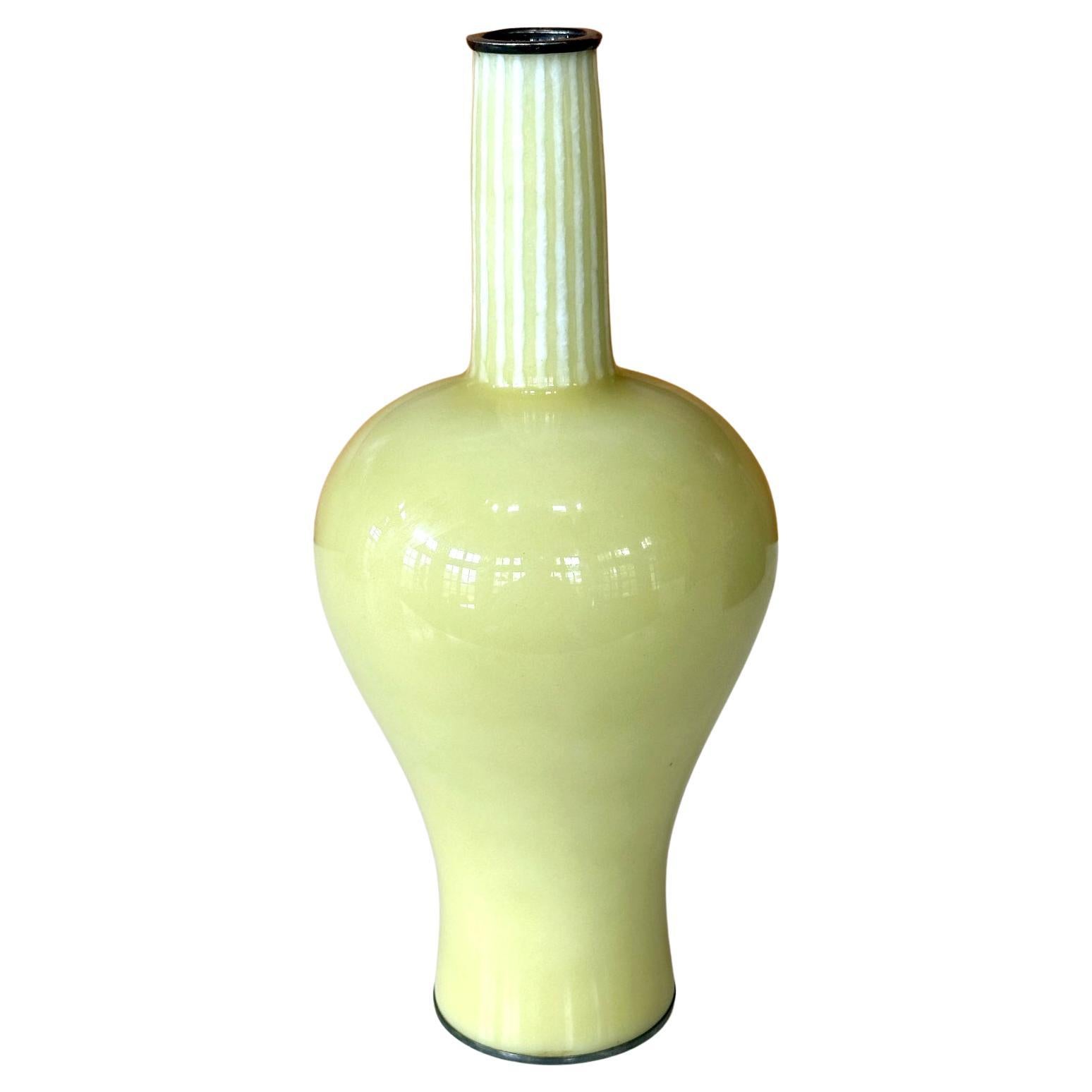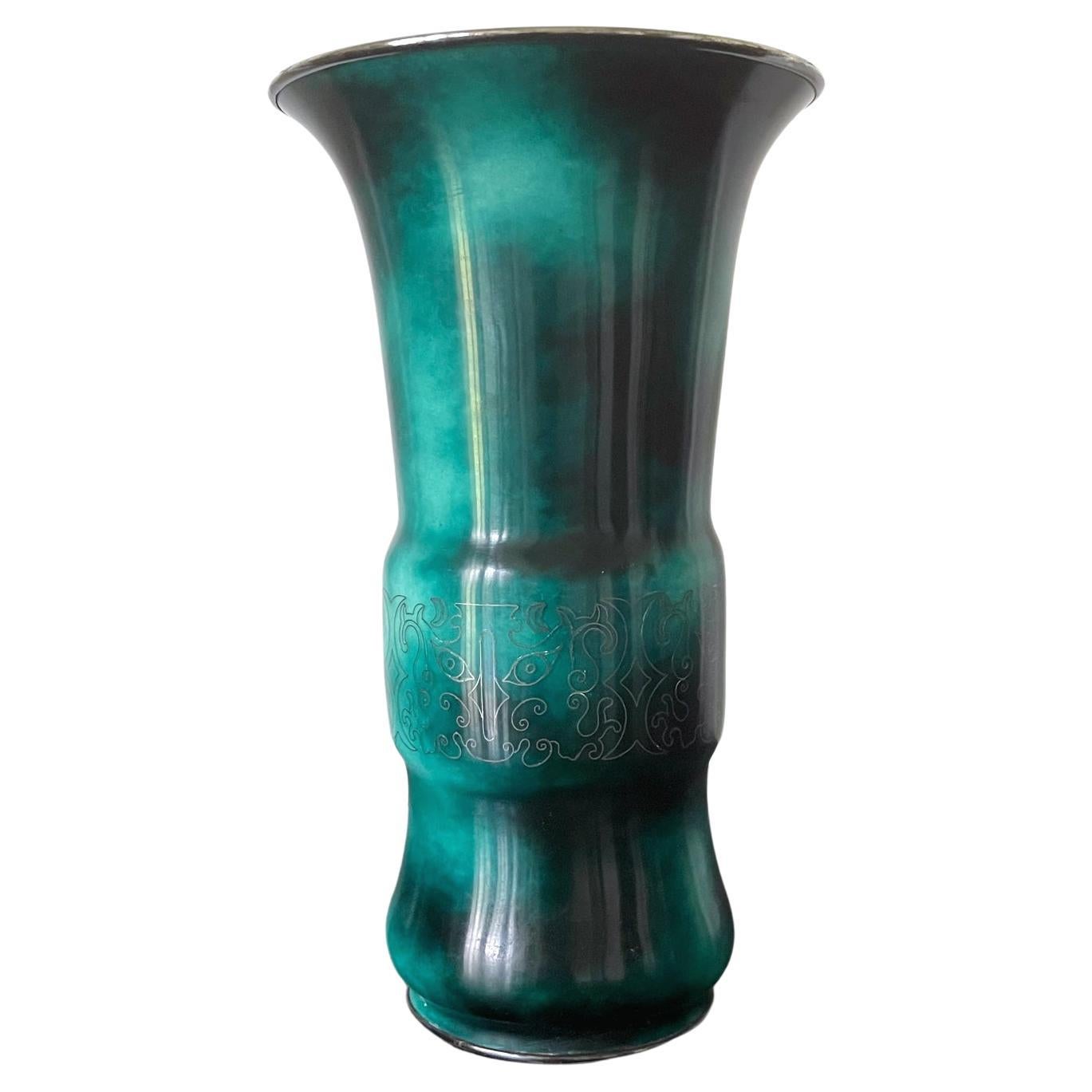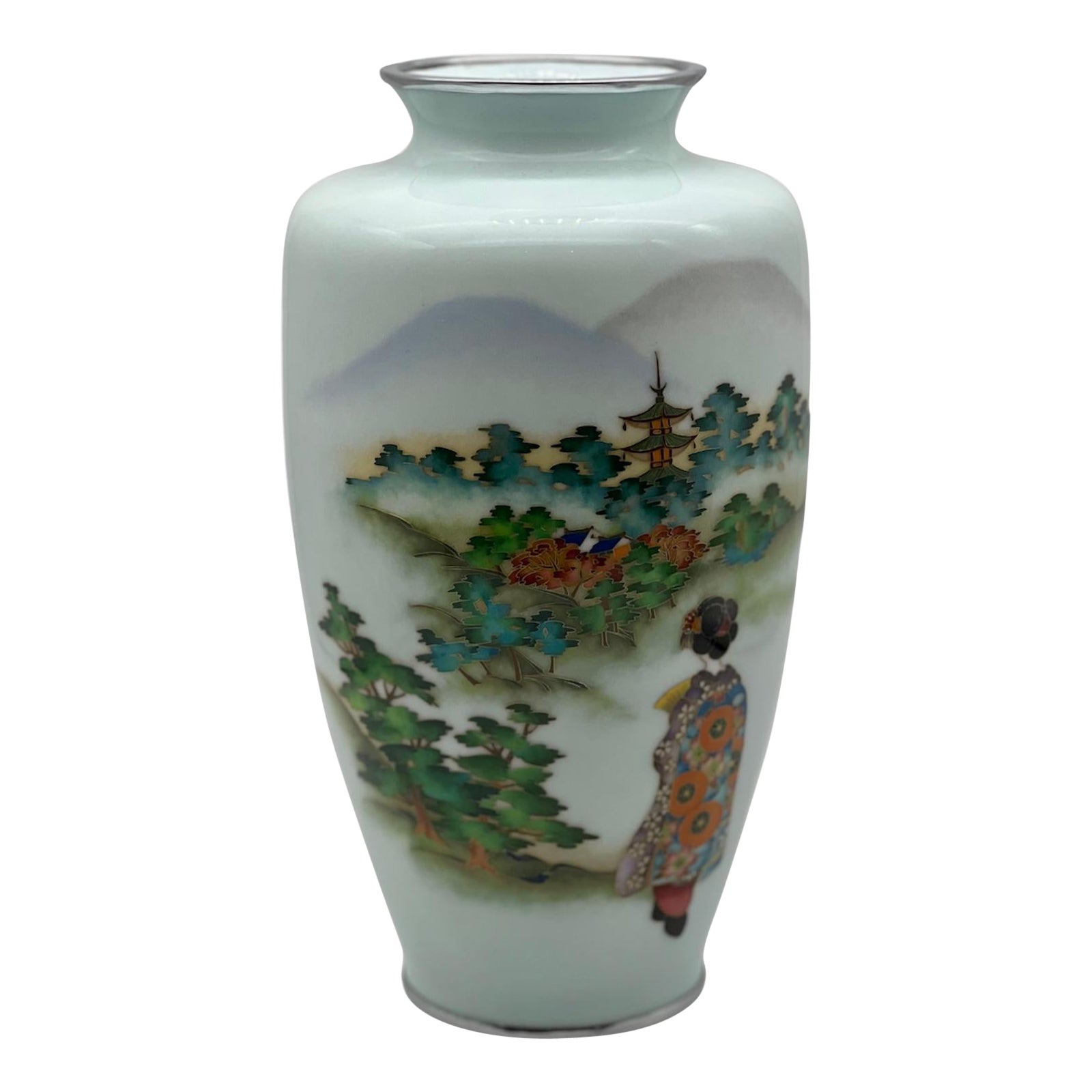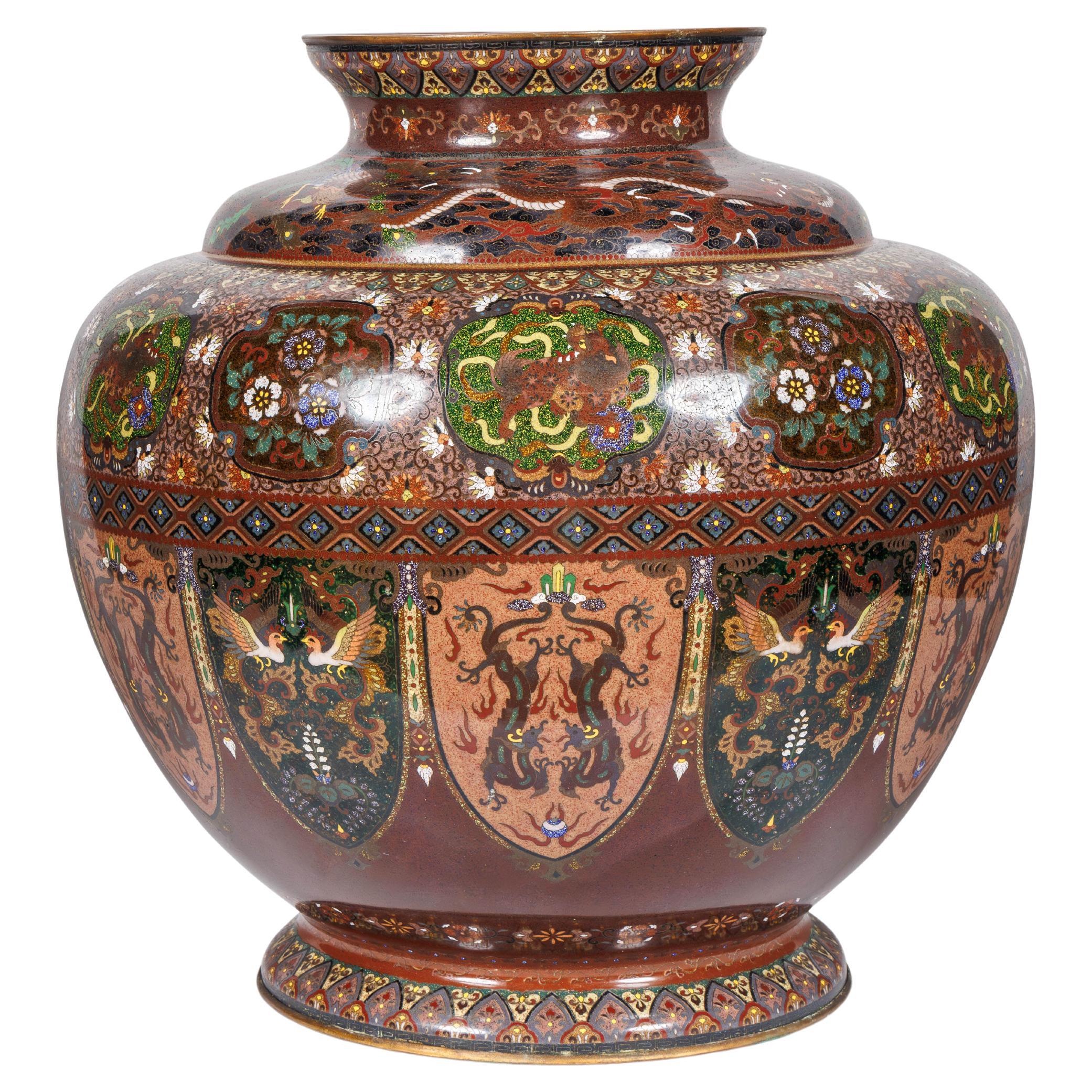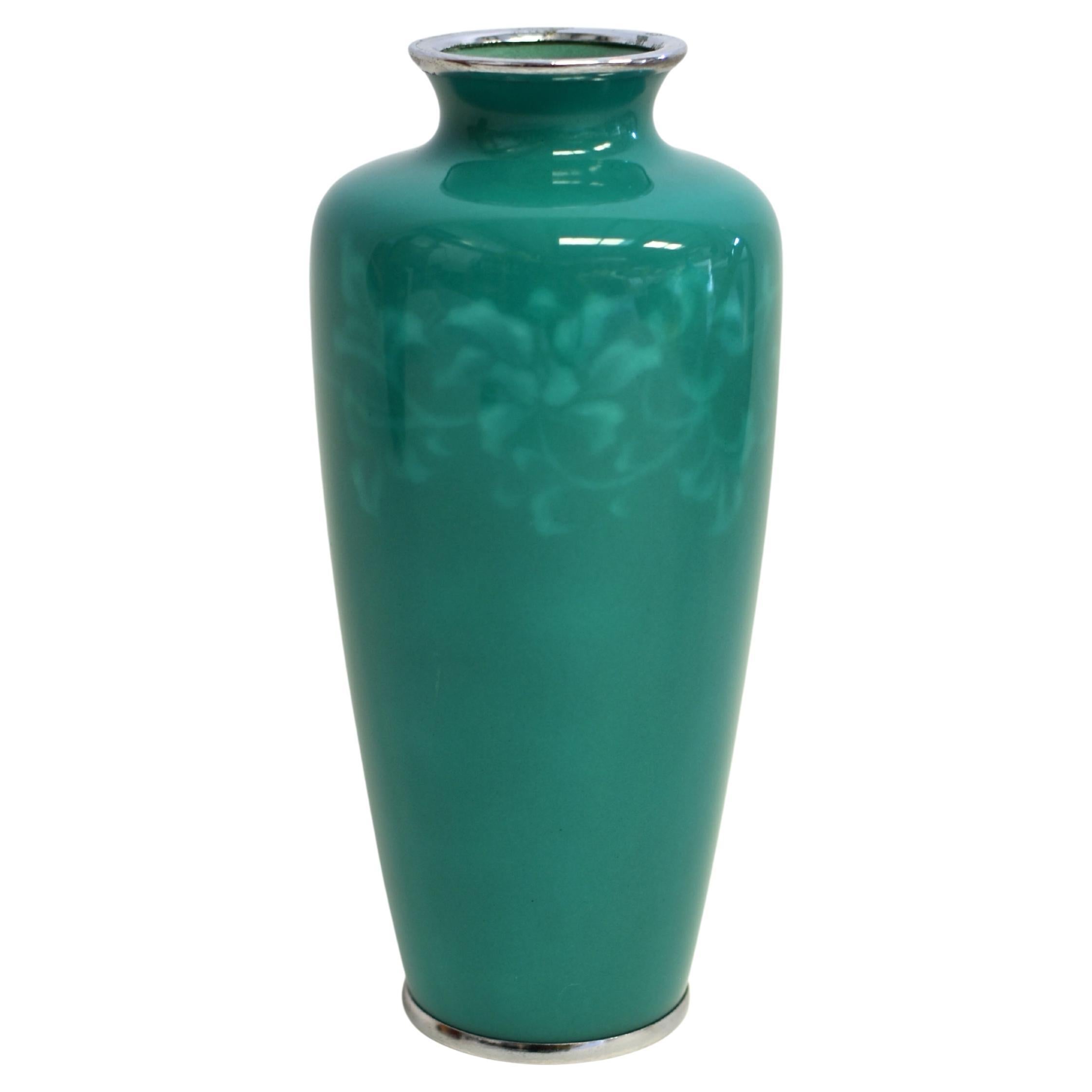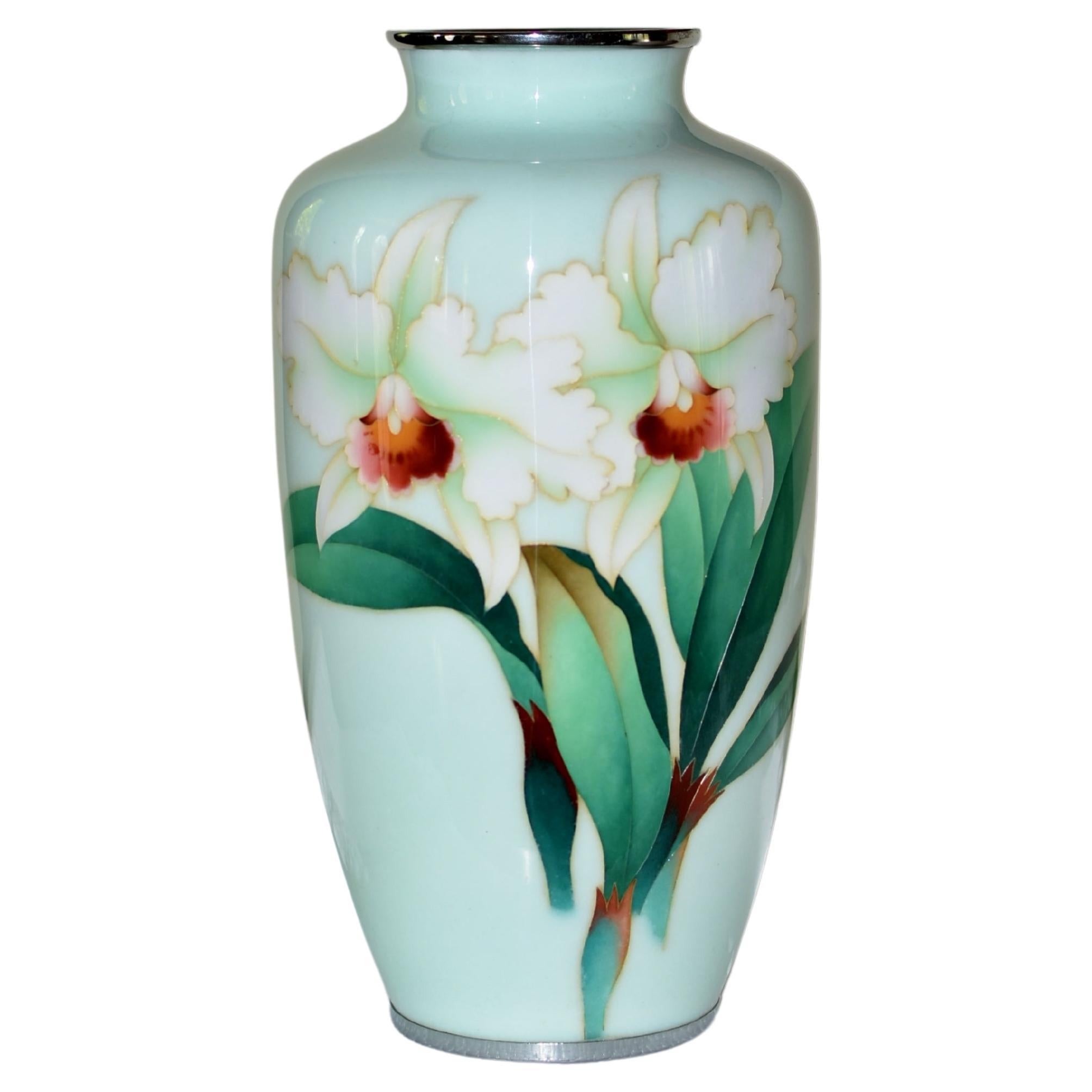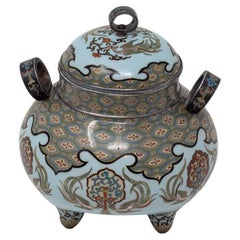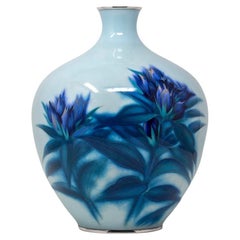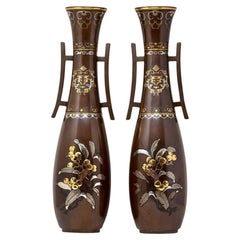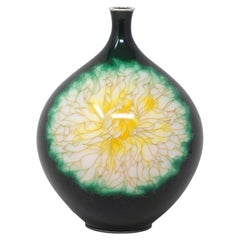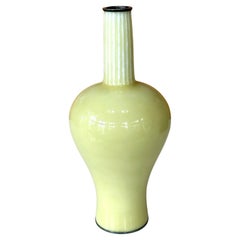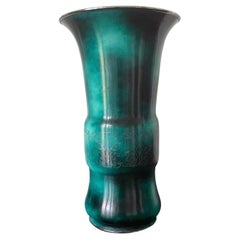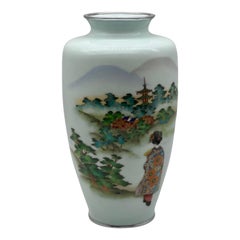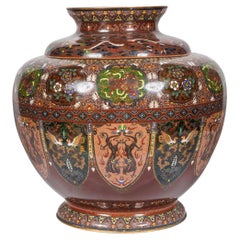Articoli simili a Japanese Meiji Period Cloisonne Enamel Vase by Ando Jubei
Vuoi altre immagini o video?
Richiedi altre immagini o video al venditore
1 di 19
Japanese Meiji Period Cloisonne Enamel Vase by Ando Jubei
Informazioni sull’articolo
Free international shipping
Ando Cloisonne Company Mark
From our Japanese collection, we are delighted to introduce this Japanese Cloisonne Enamel Vase by Ando Jubei. The Cloisonne Enamel Vase is of petite squared tapered form with a waisted neck and rounded shoulders raised upon a circular foot. The Cloisonne Enamel composed on a dark blue ground with cicada lappet borders to the top and bottom rims, the body of the vase beautifully inlaid with silver wire of varying gauge with a central scene depicting large cherry blossom above two roosters stood upon a bamboo screens with Hanashobu (Iris flowers), Kosumosu (Cosmos flowers) and a flowing river. The vase is mounted to the top and bottom in silver and features the Ando Cloisonne Company mark to the centre of the base. The Japanese Cloisonne Enamel Vase dates to the late Meiji Period (1868-1912) and the early 20th century circa 1900.
Ando Jubei (1876–1956) was a renowned Japanese cloisonne artist from Nagoya, Aichi prefecture, Japan. Jubei was considered the Meiji periods most prolific creator of presentation cloisonne, that of which were commissioned by members of the Imperial family for gifts to foreign dignitaries. Jubei alongside another artist named Hayashi Kodenji dominated Nagoya’s enamelling industry in the late Meiji era. Jubei, Namikawa Yasuyuki, and Namikawa Sosuke are considered the three artists whose technical innovations brought in the “Golden Age for Japanese cloisonné” in the late 19th century. Jubei along with his brother in law Ando Juzaemon went on to form the Ando cloisonne company in the late 19th century lead by cloisonne artist Kawade Shibataro (1856–1921).
Ando Cloisonné Company (安藤七宝店) is a Japanese cloisonne making company located in Sakae, Nagoya, central Japan. Founded in the late 19th century by Ando Jubei (Jusaburo 1876-1953) and his brother in law Andō Juzaemon they made the cloisonne company a huge success. They recruited Kawade Shibataro (1856–1921) a renowned cloisonne artist in his own right to be the head of the Ando Company studio who further developed plique-à-jour technique. During the 30 years of the 20th century Ando company employed over 50 cloisonne artists and the company was given an Imperial Warrant of Appointment to the Japanese court.
Cloisonne is a technique of decorating metalwork objects with coloured material separated by wire often made from precious metals. In the first instance the decoration is formed by creating a stencil on the metal object by affixing wires to the surface which will be visible once the product is finished allowing the artisan to craft beautiful scenes such as blossoming flowers or mythical animals by filling in the spaces with various colours.
Enamel (vitreous enamel) also known as porcelain enamel, is a material made by fusing powdered glass to a substrate by firing, usually between 750 and 850 °C. The powder melts, flows, and then hardens to a smooth, durable vitreous coating. The word vitreous comes from the Latin vitreous, meaning “glassy”.
Meiji Period was an era of Japanese history that spanned from 1868 to 1912. It was the first half of the Empire of Japan, when the Japanese people began to build a paradigm of a modern, industrialised nation state and emergent great power, influenced by Western countries and aesthetics. As a result of radically different ideas, the changes to Japan were profound and it affected the social structure, politics, economy, military, and foreign relations across the board. The period corresponded to the reign of Emperor Meiji and was preceded by the Keio era and was succeeded by the Taisho era.
Cultural Art during the Meiji Period was of particular interest to the government and they overhauled the art export market which in turn promoted Japanese arts via various world’s fairs, beginning in Vienna at the world fair in 1873. The government heavily funded the fairs and took an active role organising how Japan’s culture was presented to the world including creating a semi-public company named Kiritsu Kosho Kaisha (First Industrial Manufacturing Company). The Kiritsu Kosho Kaisha was used to promote and commercialise exports of Japanese art and established the Hakurankai Jimukyoku (Exhibition Bureau) to maintain quality standards. For the 1876 Centennial International Exhibition in Philadelphia, the Japanese government created a Centennial Office and sent a special envoy to secure space for the 30,000 items that would be displayed. The Imperial Household also took an active interest in arts and crafts, commissioning works by select artists to be given as gifts for foreign dignitaries further emphasising the high quality and importance of Japanese art. Just before the end of the 19th century in 1890, the Teishitsu Gigeiin (Artist to the Imperial Household) system was created to recognise distinguished artists. These artists were selected for their exceptionally high quality wares and talent in their own industry. Over a period of 54 years Seventy artists were appointed, amongst these were ceramicist Makuzu Kozan and cloisonné enamel artist Namikawa Yasuyuki.
- Creatore:Ando Jubei (Fabbricante)
- Dimensioni:Altezza: 12 cm (4,73 in)Larghezza: 6 cm (2,37 in)Profondità: 5 cm (1,97 in)
- Stile:Meiji (Del periodo)
- Materiali e tecniche:
- Luogo di origine:
- Periodo:1900-1909
- Data di produzione:Circa 1900
- Condizioni:Usura compatibile con l’età e l’utilizzo.
- Località del venditore:Newark, GB
- Numero di riferimento:Venditore: SPRD1stDibs: LU6971241421432
Informazioni sul venditore
5,0
Venditore professionale selezionato
Ogni venditore supera rigorosi standard di autenticità e affidabilità
Fondazione nel 2019
Venditore 1stDibs dal 2022
32 vendite su 1stDibs
Tempo di risposta standard: <1 ora
- SpedizioneRecupero del preventivo…Spedizione da: Newark, Regno Unito
- Politica di reso
Alcune parti di questa pagina sono state tradotte automaticamente. 1stDibs non può garantire che le traduzioni siano corrette. L’inglese è la lingua predefinita del sito.
Garanzia di autenticità
Nell’improbabile caso in cui si verifichi un problema con l’autenticità di un articolo, contattaci entro un anno per ottenere un rimborso completo. DettagliGaranzia di rimborso
Se il tuo articolo non corrisponde alla descrizione, è danneggiato durante il trasporto o non arriva, contattaci entro 7 giorni per un rimborso completo. DettagliAnnullamento entro 24 ore
Hai un periodo di tolleranza di 24 ore per annullare il tuo acquisto, senza necessità di fornire spiegazioni.Venditori professionali selezionati
I nostri venditori di livello internazionale devono aderire a rigorosi standard di servizio e qualità, garantendo l’integrità delle inserzioni.Garanzia miglior prezzo
Se scopri che un venditore ha pubblicato altrove lo stesso articolo a un prezzo più basso, applicheremo lo stesso prezzo.Consegna globale affidabile
La nostra rete di vettori leader del settore offre opzioni di spedizione specializzate in tutto il mondo, inclusa la consegna personalizzata.Altro da questo venditore
Mostra tuttoKoro giapponese in smalto cloisonne del periodo Meiji firmato Tsukamoto Hikokichi
Il Koro, di qualità eccezionale, ha una forma tozza e bulbosa con tre manici ad anello e un coperchio rimovibile che poggia su tre piedi affusolati. Il Koro ha un fondo blu cielo amp...
Categoria
Inizio XX secolo, Giapponese, Meiji, Oggetti in metallo
Materiali
Metallo, Smalto, Filo metallico
10.086 USD
Spedizione gratuita
Vaso in smalto cloisonne giapponese del periodo Tashio (1912-1926) Ando Company
Di Ando Jubei
Il vaso, di forma globosa, è decorato con una base in smalto blu pastello e tulipani blu in fiore al centro. La base è firmata al centro con il marchio dell'azienda Ando e il bordo c...
Categoria
XX secolo, Giapponese, Meiji, Vasi
Materiali
Metallo, Argento, Smalto, Filo metallico
5.080 USD
Spedizione gratuita
Coppia di vasi giapponesi in bronzo Periodo Meiji
Una bella coppia di vasi giapponesi in bronzo di grandi dimensioni. I vasi sono sormontati da colli a vita fiancheggiati da due manici sporgenti con accenti a forma di Torri giappone...
Categoria
Di antiquariato/d’epoca, Fine XIX secolo, Giapponese, Meiji, Oggetti in ...
Materiali
Metallo, Oro, Argento, Bronzo, Rame
Vaso giapponese in smalto cloisonne della ditta Ando
Di Ando Jubei
Fiore astratto di crisantemo
Dalla nostra collezione giapponese, siamo lieti di presentarti questo vaso giapponese in smalto cloisonne della Ando Company. Il vaso giapponese in smal...
Categoria
Metà XX secolo, Giapponese, Art Déco, Vasi
Materiali
Argento, Smalto
Vaso giapponese in smalto cloisonne della ditta Ando
Di Ando Jubei
Rosa Bianca
Dalla nostra collezione giapponese, siamo lieti di offrirti questo vaso giapponese in smalto cloisonne della Ando Company. Il vaso in smalto cloisonne di forma globosa c...
Categoria
Metà XX secolo, Giapponese, Art Déco, Vasi
Materiali
Argento, Smalto
Vaso antico giapponese in smalto cloisonne Hayashi Kodenji
PERIODO MEIJI (1868-1912)
Dalla nostra collezione giapponese, siamo lieti di presentare questo vaso giapponese di smalto cloisonne di buone dimensioni. Il vaso ha una forma delicat...
Categoria
Di antiquariato/d’epoca, Inizio Novecento, Giapponese, Meiji, Oggetti in...
Materiali
Oro, Argento, Smalto
Ti potrebbe interessare anche
Vaso giapponese senza fili in cloisonne Musen di Ando Jubei
Di Ando Jubei
Vaso di cloisonne giapponese a forma di bottiglia realizzato da Ando Jubei (1876-1963) intorno agli anni 1910-20 (periodo Meiji-Taisho). Il vaso è caratterizzato da una superficie co...
Categoria
Inizio XX secolo, Giapponese, Meiji, Oggetti in metallo
Materiali
Argento, Smalto
Vaso giapponese in cloisonne con intarsi in argento di Ando Jubei
Di Ando Jubei
Vaso in cloisonne giapponese della ditta Ando del 1910-30 circa, fine del periodo Meiji - Tasho. Il vaso riprende la forma arcaica dei vasi cinesi in bronzo noti come "Zun". La sua s...
Categoria
Vintage, Anni 1920, Giapponese, Meiji, Oggetti in metallo
Materiali
Metallo, Argento
Un grande vaso giapponese in smalto cloisonne attribuito ad Ando Jubei
Di Ando Jubei
Un grande vaso giapponese in smalto cloisonne attribuito ad Ando Jubei.
Periodo Taisho (1912 - 1926)
Un grande vaso Cloisonne-Enamel a balaustro lavorato in musen e filo d'argento ...
Categoria
Inizio XX secolo, Giapponese, Oggetti in metallo
Materiali
Smalto
Capolavoro Meiji di Ando Jubei: Vaso cloisonné marrone con draghi e fenice
Di Ando Jubei
Capolavoro Meiji attribuito ad Ando Jubei: Vaso cloisonné marrone con draghi e fenice, circa 1895
Questo monumentale vaso cloisonné giapponese del periodo Meiji, attribuito allo sti...
Categoria
Di antiquariato/d’epoca, XIX secolo, Giapponese, Meiji, Oggetti in metallo
Materiali
Smalto
Vaso giapponese Cloisonné Ando Jubei firmato 8,5" Clematis senza fili
Di Ando Jubei
Uno squisito vaso cloisonné senza fili di Ando Jubei. Con il suo caratteristico smalto verde, raffigurante un intricato disegno arabesco di una vite di clematide in fiore sotto lo sm...
Categoria
XX secolo, Giapponese, Meiji, Vasi
Materiali
Metallo, Smalto
Grande vaso cloisonné giapponese firmato Ando Jubei, orchidee 10"
Di Ando Jubei
Un grande e raro capolavoro dell'arte cloisonné senza fili di Ando Jubei in ottime condizioni, che raffigura due orchidee in piena fioritura, catturandone la delicata bellezza e la v...
Categoria
XX secolo, Giapponese, Meiji, Vasi
Materiali
Metallo, Smalto
